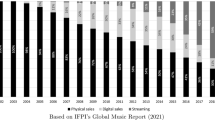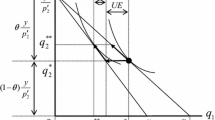Abstract
The superstar model predicts skewness of market outcomes and returns to artist quality. We test and confirm these predictions using a unique data set on popular music.
Similar content being viewed by others
References
Adler, M. (1985) ‘Stardom and Talent’, American Economic Review 75, 208–212.
Crain, W. and Tollison, R.D. (1997) ‘Economics and the Architecture of Popular Music’, Journal of Economic Behavior and Organization 901, 185–205.
Economic Report of the President (1994) United State Government Printing Office, Washington.
Frank, R.H. and Cook, P.J. (1995) The Winner-Take-All Society, Free Press, New York.
Hamlen, W.(1991) ‘Superstardom in Popular Music: Empirical Evidence’, Review of Economics and Statistics 75, 729–733.
Hamlen, W. (1994) ‘Variety and Superstardom in Popular Music’, Economic Inquiry 32, 395–406.
Levy, D. and Feigenbaum, S. (1986) ‘Death, Debt, and Democracy. In: J.M. Buchanan, C.K. Rowley, and R.D. Tollison (eds.), Deficits, Blackwell, Oxford, pp. 236–262.
MacDonald, G.M. (1988) ‘The Economics of Rising Stars’, American Economic Review 78, 155–166.
Marshall, A. (1947) Principles of Economics, MacMillan, London.
Rosen, S. (1981) ‘The Economics of Superstars’, American Economic Review 71, 845–858.
Stigler, G. and Becker, G. (1977) ‘De Gustibus non est Disputadum’, America Economic Review 67, 76–90.
Throsby, D. (1994) ‘The Production and Consumption of the Arts: A View of Cultural Economics’, Journal of Economic Literature XXXII, 1–19.
Billboard Magazine, BPI Communications, New York, various issues.
U.S. Department of Commerce, Bureau of the Census. U.S. Population Estimates by Age, Sex, Race, and Hispanic Origin, U.S. Government Printing Office, Washington, DC, various editions.
U.S. Department of Commerce, Bureau of the Census. Statistical Abstract. Washington D.C.: U.S. Government Printing Office, various editions.
Author information
Authors and Affiliations
Rights and permissions
About this article
Cite this article
Crain, W.M., Tollison, R.D. Consumer Choice and the Popular Music Industry: A Test of the Superstar Theory. Empirica 29, 1–9 (2002). https://doi.org/10.1023/A:1014651130414
Issue Date:
DOI: https://doi.org/10.1023/A:1014651130414




